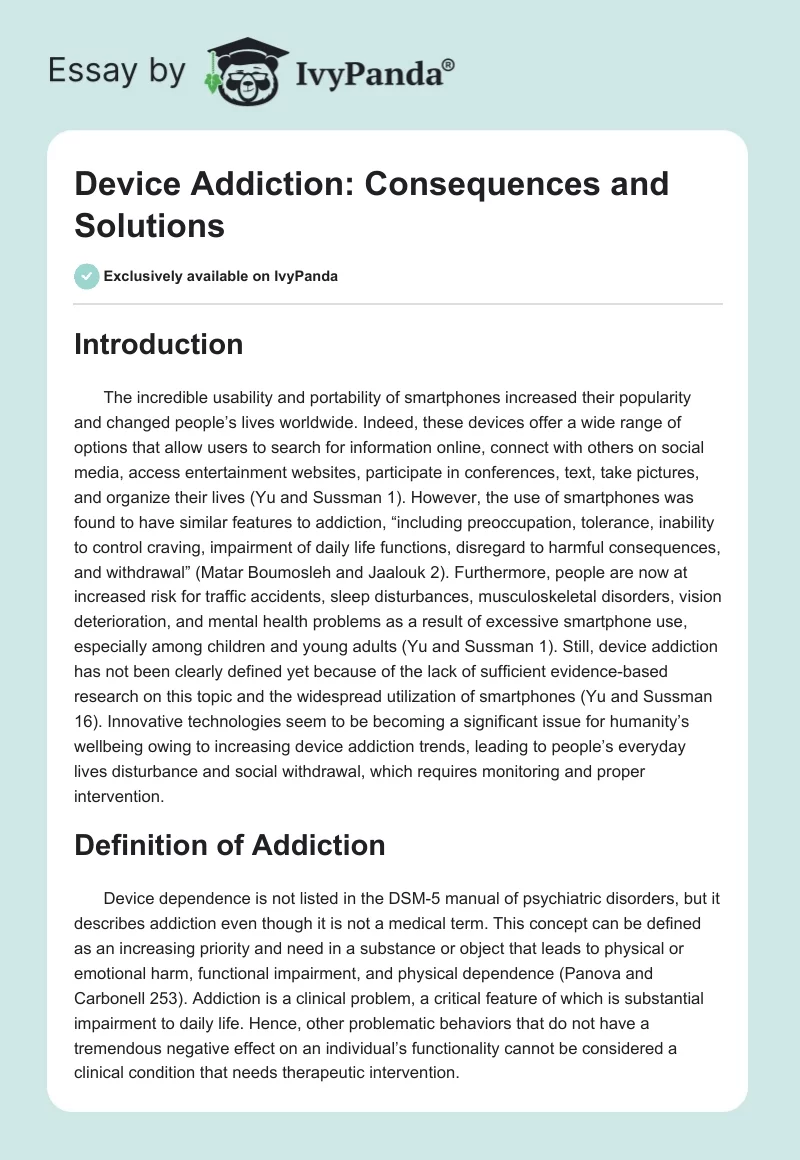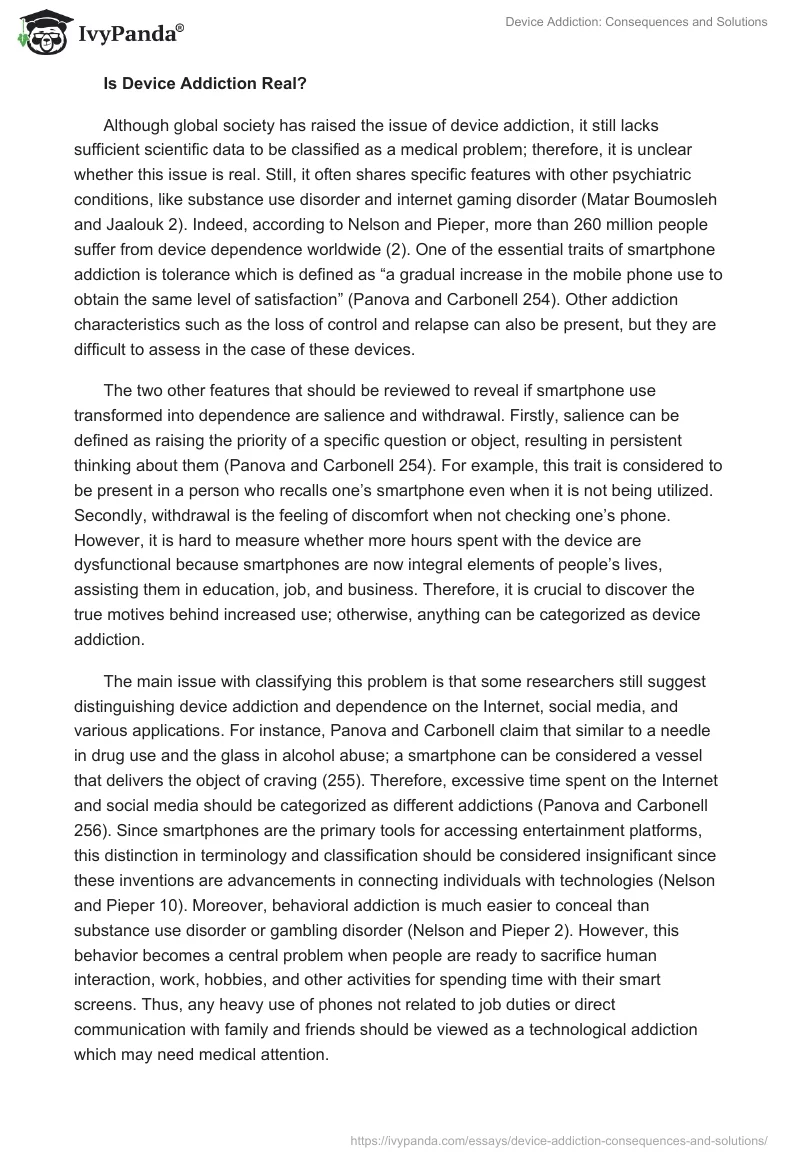Introduction
The incredible usability and portability of smartphones increased their popularity and changed people’s lives worldwide. Indeed, these devices offer a wide range of options that allow users to search for information online, connect with others on social media, access entertainment websites, participate in conferences, text, take pictures, and organize their lives (Yu and Sussman 1). However, the use of smartphones was found to have similar features to addiction, “including preoccupation, tolerance, inability to control craving, impairment of daily life functions, disregard to harmful consequences, and withdrawal” (Matar Boumosleh and Jaalouk 2). Furthermore, people are now at increased risk for traffic accidents, sleep disturbances, musculoskeletal disorders, vision deterioration, and mental health problems as a result of excessive smartphone use, especially among children and young adults (Yu and Sussman 1). Still, device addiction has not been clearly defined yet because of the lack of sufficient evidence-based research on this topic and the widespread utilization of smartphones (Yu and Sussman 16). Innovative technologies seem to be becoming a significant issue for humanity’s wellbeing owing to increasing device addiction trends, leading to people’s everyday lives disturbance and social withdrawal, which requires monitoring and proper intervention.
Definition of Addiction
Device dependence is not listed in the DSM-5 manual of psychiatric disorders, but it describes addiction even though it is not a medical term. This concept can be defined as an increasing priority and need in a substance or object that leads to physical or emotional harm, functional impairment, and physical dependence (Panova and Carbonell 253). Addiction is a clinical problem, a critical feature of which is substantial impairment to daily life. Hence, other problematic behaviors that do not have a tremendous negative effect on an individual’s functionality cannot be considered a clinical condition that needs therapeutic intervention.
Is Device Addiction Real?
Although global society has raised the issue of device addiction, it still lacks sufficient scientific data to be classified as a medical problem; therefore, it is unclear whether this issue is real. Still, it often shares specific features with other psychiatric conditions, like substance use disorder and internet gaming disorder (Matar Boumosleh and Jaalouk 2). Indeed, according to Nelson and Pieper, more than 260 million people suffer from device dependence worldwide (2). One of the essential traits of smartphone addiction is tolerance which is defined as “a gradual increase in the mobile phone use to obtain the same level of satisfaction” (Panova and Carbonell 254). Other addiction characteristics such as the loss of control and relapse can also be present, but they are difficult to assess in the case of these devices.
The two other features that should be reviewed to reveal if smartphone use transformed into dependence are salience and withdrawal. Firstly, salience can be defined as raising the priority of a specific question or object, resulting in persistent thinking about them (Panova and Carbonell 254). For example, this trait is considered to be present in a person who recalls one’s smartphone even when it is not being utilized. Secondly, withdrawal is the feeling of discomfort when not checking one’s phone. However, it is hard to measure whether more hours spent with the device are dysfunctional because smartphones are now integral elements of people’s lives, assisting them in education, job, and business. Therefore, it is crucial to discover the true motives behind increased use; otherwise, anything can be categorized as device addiction.
The main issue with classifying this problem is that some researchers still suggest distinguishing device addiction and dependence on the Internet, social media, and various applications. For instance, Panova and Carbonell claim that similar to a needle in drug use and the glass in alcohol abuse; a smartphone can be considered a vessel that delivers the object of craving (255). Therefore, excessive time spent on the Internet and social media should be categorized as different addictions (Panova and Carbonell 256). Since smartphones are the primary tools for accessing entertainment platforms, this distinction in terminology and classification should be considered insignificant since these inventions are advancements in connecting individuals with technologies (Nelson and Pieper 10). Moreover, behavioral addiction is much easier to conceal than substance use disorder or gambling disorder (Nelson and Pieper 2). However, this behavior becomes a central problem when people are ready to sacrifice human interaction, work, hobbies, and other activities for spending time with their smart screens. Thus, any heavy use of phones not related to job duties or direct communication with family and friends should be viewed as a technological addiction which may need medical attention.
Negative Consequences of Smartphone Addiction
Although no data are available about the negative consequences of device addiction, it affects people’s mental and physical health. For example, according to Panova and Carbonell, smartphone users occasionally report mild tendonitis, wrist pain, blurred vision, headaches, light-headedness, and sometimes traffic accidents (254). Furthermore, the study by Matar Boumosleh and Jaalouk showed that students with device addiction were found to have sleep disturbance, which was an obstacle to their daily activities, leading to a drop in academic performance (7). Specifically, 35% of the study participants reported tiredness during the day due to poor sleep quality caused by smartphone use (Matar Boumosleh and Jaalouk 9). Still, the lack of data is not proof of no effect but indicates insufficient research in this field. The psychological issues associated with smartphone overuse include social withdrawal, low self-esteem, anxiety, and depression (Matar Boumosleh and Jaalouk 1; Yu and Sussman 16). If these problems are not timely and adequately addressed, the outcomes for people addicted to their devices may be severe.
A Possible Solution for This Problem
The severe device addiction cases and mild disturbances may be resolved with behavioral change. Researchers suggest developing self-control in all types of addictions because dependence develops from an inability to understand and regulate one’s thoughts and emotions, particularly in adolescents and young adults who prefer instant gratification (Schulz van Endert 3). Hence, behavioral training should be applied to help them learn to delay cravings and overcome smartphone addiction (Schulz van Endert 3). In fact, Schulz van Endert states that “exertion of self-control suppresses the impulse of choosing a smaller, immediate reward and biases choice behavior towards the larger, delayed reward” (3). Furthermore, regulation of emotions and behaviors is a learned trait that should be taught in families, schools, and other educational institutions. Lastly, another possibility is sending these people for therapeutic consultations if the problem is beyond parents’ and teachers’ competence.
Conclusion
In summary, device addiction appears to be a serious issue that concerns the global population but is not adequately investigated. Since many people use smartphones, it is sometimes challenging to distinguish between abnormal and regular usage. Indeed, device addiction has some common features with other conditions of analogous attitude and behavior. Specifically, people with smartphone dependence seem to have tolerance, salience, and withdrawal symptoms. Some scholars suggest that device addiction should be categorized as a different disorder. However, new smartphone features can be considered an extension of technological advancement; thus, making such a distinction between the Internet and device addiction is not critical. Instead, research should focus on understanding the neurobiology of smartphone overuse and developing new methods of training self-control to reduce screen time, preventing various negative physiological and mental consequences of this addiction.
Works Cited
Matar Boumosleh, Jocelyne, and Doris Jaalouk. “Depression, Anxiety, and Smartphone Addiction in University Students-A Cross-Sectional Study.” PloS One, vol. 12, no. 8, 2017, pp. 1-14.
Nelson, Justin J., and Christopher M. Pieper. “Who’s an iAddict? A Sociodemographic Exploration of Device Addiction Among American Adults.” Social Science Quarterly, vol. 101 no. 5, 2020, pp. 2071-2084.
Panova, Tayana, and Xavier Carbonell. “Is Smartphone Addiction Really an Addiction?” Journal of Behavioral Addictions, vol. 7, no. 2, 2018, pp. 252-259.
Schulz van Endert, Tim. “Addictive Use of Digital Devices in Young Children: Associations with Delay Discounting, Self-Control and Academic Performance.” PloS One, vol. 16, no. 6, 2021, pp. 1-12.
Yu, Sheila, and Steve Sussman. “Does Smartphone Addiction Fall on a Continuum of Addictive Behaviors?” International Journal of Environmental Research and Public Health, vol. 17, no. 2, 2020, pp. 1-21.


